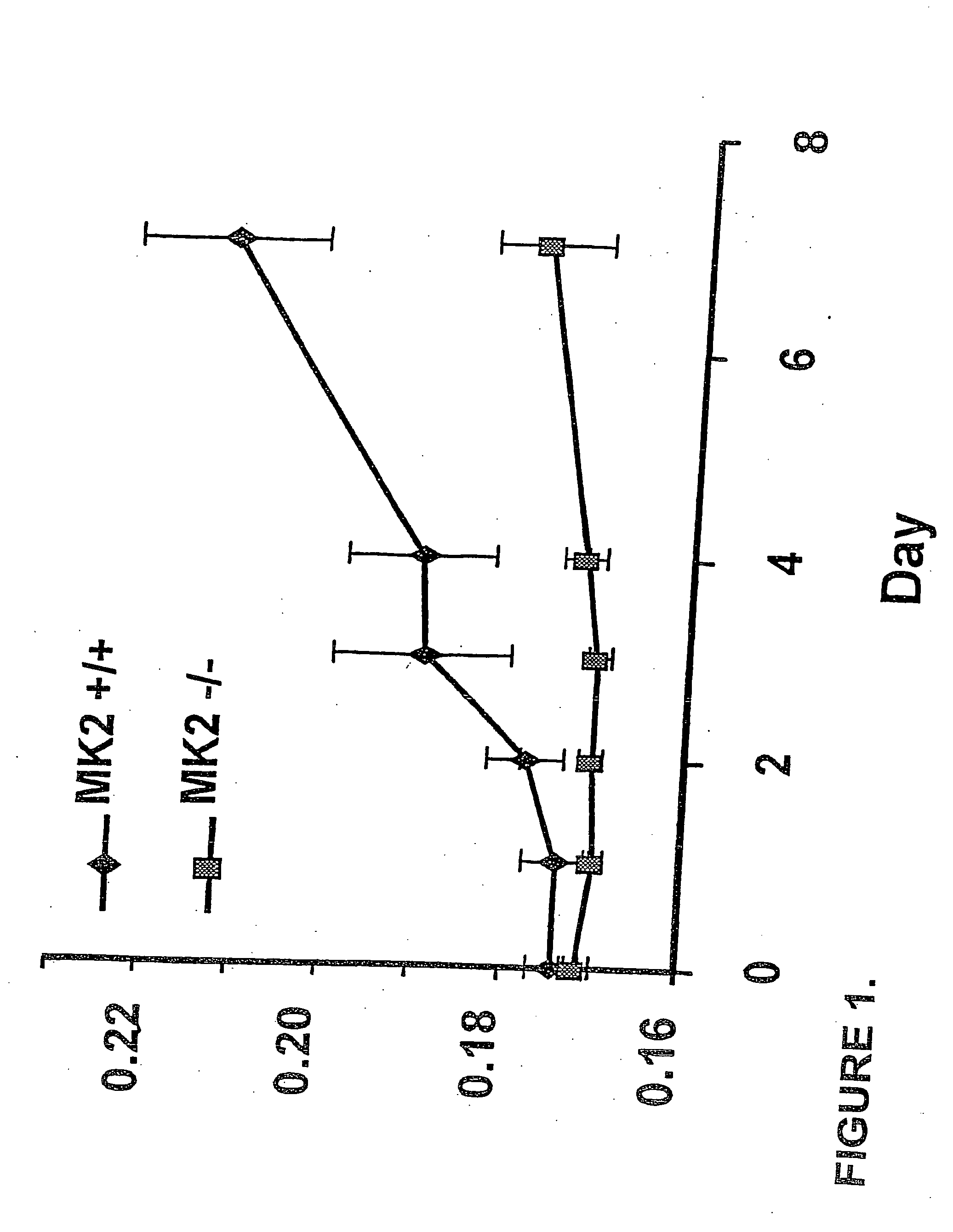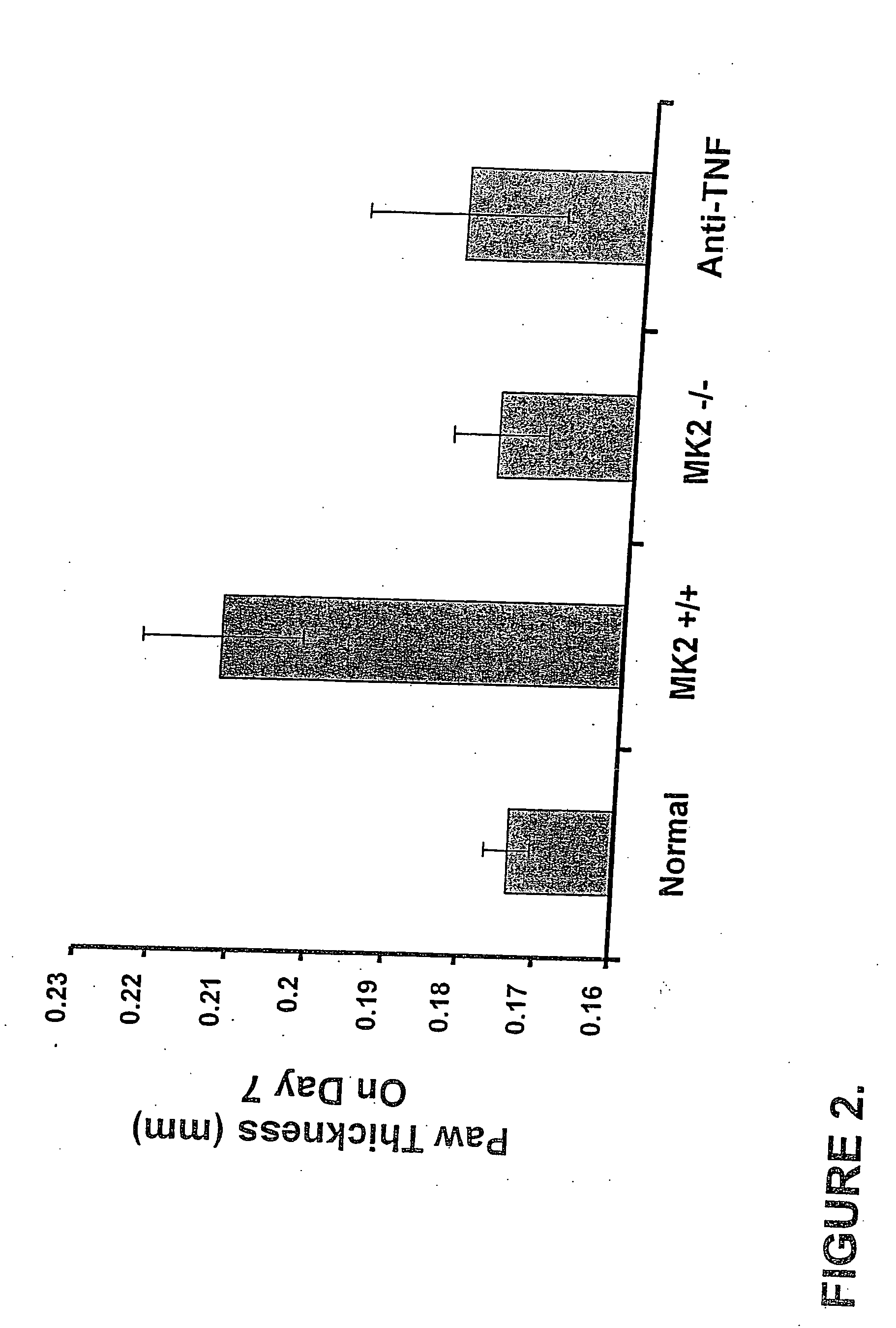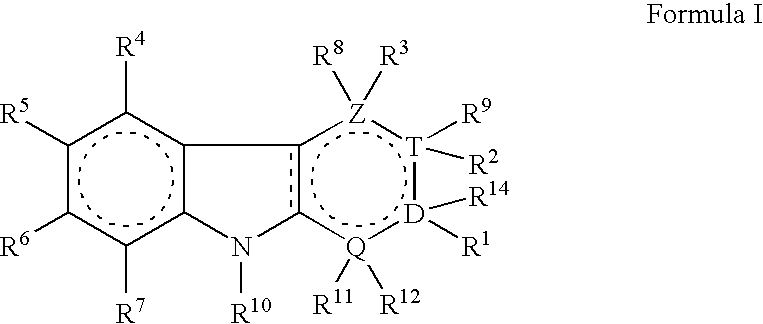Beta-carboline compounds and analogues thereof as mitogen-activated protein kinase-activated protein kinase-2 inhibitors
a technology of mitogen-activated protein and mitogen-activated protein, which is applied in the field of mitogen-activated protein kinase-activated protein kinase-2 inhibitors, can solve the problems that beta-carbolines have not been described as effective for treating tnf-mediated inflammatory diseases or disorders
- Summary
- Abstract
- Description
- Claims
- Application Information
AI Technical Summary
Benefits of technology
Problems solved by technology
Method used
Image
Examples
example 1
[0588] This example illustrates the production of 3-(aminomethyl)-6-methoxy-2,3,4,9-tetrahydro-1H-beta-carbolin-1-one hydrochloride.
Step A: Production of Ethyl 3-[(dimethylamino)methyl]-5-methoxy-1H-indole-2-carboxylate
[0589] A mixture of ethyl 5-methoxy-1H-indole-2-carboxylate (29.9 grams (g), 136 millimoles (mmol)) in methylene chloride (600 milliliters (mL)) was treated with N,N-dimethylmethylene-ammonium chloride (19.2 g, 205 mmol) at room temperature with mechanical stirring. The reaction mixture was stirred at 40° C. for 20 hours. The mixture was diluted with diethyl ether and then filtered. The white solid was washed with diethyl ether and was then partitioned between 1 N NaOH and methylene chloride. The aqueous layer was extracted with methylene chloride. The organic layer was washed with brine, dried (Na2SO4), and concentrated to give the title compound as a white solid (37.5 g, quantitative): 1HNMR (300 MHz, CDCl3) δ 8.71 (s, 1H), 7.21 (s, 1H), 7.17 (d, 1H), 6.94 (dd, 1...
example 2
[0596] This example illustrates the production of 3-(2-aminoethyl)-6-methoxy-2,3,4,9-tetrahydro-1H-beta-carbolin-1-one trifluoroacetate.
Step A. Production of (6-methoxy-1-oxo-2,3,4,9-tetrahydro-1H-beta-carbolin-3-yl)acetonitrile
[0597] A solution of (6-methoxy-1-oxo-2,3,4,9-tetrahydro-1H-beta-carbolin-3-yl)methyl methanesulfonate (product of Example 1, step D; 500 mg, 1.54 mmol) and potassium cyanide (150 mg, 2.31 mmol) in dimethylformamide (8 mL) was stirred at 80° C. for 16 hours. The reaction mixture was partitioned between water and ethyl acetate. The aqueous layer was extracted with ethyl acetate. The combined organic extracts were washed with water, saturated LiCl and brine, dried (Na2SO4), and concentrated. The residue was triturated with hot ethyl acetate to give the title compound as an off-white solid (218 mg). A second crop was obtained from the mother liquor (39 mg). The mother liquor was purified by flash chromatography (25→75% ethyl acetate / hexanes) to yield another ...
example 3
[0599] This example illustrates the production of 3-(3-aminopropyl)-6-methoxy-2,3,4,9-tetrahydro-1H-beta-carbolin-1-one trifluoroacetate.
Step A: Production of Ethyl 5-methoxy-3-(5-methoxy-2-nitro-5-oxopentyl)-1H-indole-2-carboxylate
[0600] A solution of ethyl 3-[(dimethylamino)methyl]-5-methoxy-1H-indole-2-carboxylate (product of Example 1, step A; 2.0 g, 7.2 mmol) in methanol (50 mL) was treated with dimethylsulfate (1.4 mL, 14.4 mmol), methyl 4-nitro-butyrate (4.0 mL, 31.2 mmol), and sodium methoxide (16.0 mL, 8.0 mmol) and allowed to stir at room temperature for 2 hours. The reaction contents were poured into water (200 mL) and the resulting precipitate was filtered and dried to give ethyl 5-methoxy-3-(5-methoxy-2-nitro-5-oxopentyl)-1H-indole-2-carboxylate as a white solid (2.0 g, 73%): 1HNMR (400 MHz, DMSO-d6) 611.64 (s, 1H), 7.29 (d, 1H), 7.06 (d, 1H), 6.90 (dd, 1H), 4.92 (bs, 1H), 4.30 (q, 2H), 3.76 (s, 3H), 3.62 (m, 1H), 3.52 (s, 3H), 3.49 (m, 1H), 2.36 (t, 1H), 2.20 (m, 1H...
PUM
 Login to View More
Login to View More Abstract
Description
Claims
Application Information
 Login to View More
Login to View More - R&D
- Intellectual Property
- Life Sciences
- Materials
- Tech Scout
- Unparalleled Data Quality
- Higher Quality Content
- 60% Fewer Hallucinations
Browse by: Latest US Patents, China's latest patents, Technical Efficacy Thesaurus, Application Domain, Technology Topic, Popular Technical Reports.
© 2025 PatSnap. All rights reserved.Legal|Privacy policy|Modern Slavery Act Transparency Statement|Sitemap|About US| Contact US: help@patsnap.com



